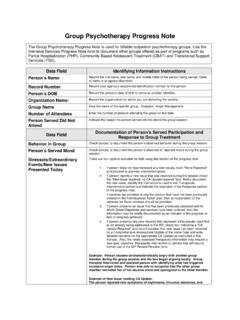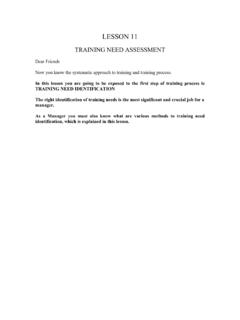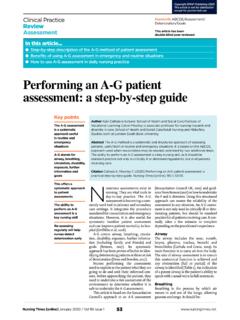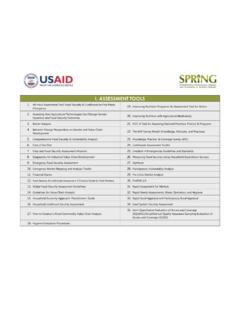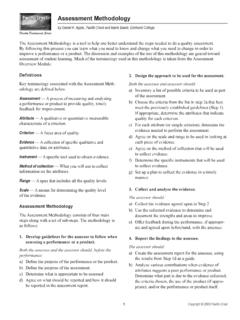Transcription of Adult Comprehensive Assessment
1 Adult Comprehensive Assessment The Adult Comprehensive Assessment provides a standard format to assess mental health, substance use and functional needs of persons served. This Assessment provides a summary of assessed needs that serve as the basis of Goals and Objectives in the Individualized Action Plan. Some of the sections of the Adult Comprehensive Assessment may be completed by the person served prior to the initial intake evaluation. It is at the discretion of each individual agency whether they choose to incorporate this process into the intake evaluation or not. If needed, agencies should use their own Functional Assessment to assess any needs that are not addressed in the MSDP Adult Comprehensive Assessment . Data Field Identifying Information Person s Name Record the first name, last name, and middle initial of the person being served. Order of name is at agency discretion. Record Number Record your agency s established identification number for the person.
2 Date of Admission Record the date of admission per agency policy (this should be the first service date for this service episode). Organization/Program Name Record the organization and Program for whom you are delivering the service. DOB Record the person s date of birth Gender Indicate person s gender by checking the appropriate box. If checking Transgender box, also complete box of current gender designation for insurance purposes. Data Field Presenting Concerns (in Person s/Family s Own Words) Referral Source Document the referral source. Reason for Referral Document the reason the person was referred for services, from the person s and the referent s point of view. What Occurred to Cause the Person to Seek Services Now (Note Precipitating Event, Symptoms, Behavioral and Functioning Needs) Record (in person s own words) precipitating factors as reported by the person served or others that has led up to the event that caused the person to seek services.
3 Record troublesome symptoms, behaviors and/or problems affecting day-to-day functioning, relationships and work, as reported by the person served. Adult Outpatient Example: Mary reported that about a month ago when she was lying in her bed going to sleep, her heart began to beat quickly. She reported she began to have difficulty breathing, had a pain in her chest or her heart, and she couldn t stop shaking. She stated that she was scared she was going crazy. Mary stated that this experience felt like it lasted forever. She called a friend to come over and stated later that many of her symptoms had lessened by the time her friend arrived. A couple of days later, Mary said she had another experience like this with similar symptoms during the day. Mary said both experiences started without warning and that she is nervous that it might happen again. She reported that she has had particular difficulty falling asleep. CBFS Example: In the past year, Jean has worked diligently toward the goal of becoming her own rep payee.
4 Now that she has achieved her goal and manages her own money, she is looking for assistance to establish her own apartment. "I just want to get out of this program and live on my own like a normal person," Jean explains. "I know I'm going to need some help to get started - especially with medications and getting a job." Jean had entered WSH in 2009 after an attempted suicide by overdose, which had been prompted by intense feelings of being overwhelmed, anxious and experiencing auditory hallucinations commanding her to kill herself. Prior to her WSH hospitalization, she had a one month hospitalization in 2006 at UMass 8 East prompted by auditory hallucinations, increased agitation and mood instability. She also spent approximately 4 months in 2000-2001 at the Sunrise House program after reporting suicidal thoughts, cutting her wrists and abusing substances. BSAS Example: Client was arrested for DUI which scared him.
5 The DAE program referred him for further Assessment at the Outpatient Counseling Program. Data Field Living situation What is the person s current living situation Check the box (or boxes) to indicate what the person s current living situation is. You are not required to check off one box under each category ( , person s home, residential care/treatment facility, other). For example, if the person lives in supportive housing, check off that box and move to the next question. If applicable, you may check off more than one box (see example given below for Residential Care/Treatment Facility). Residential Care/Treatment Facility Check if person served is in one of these living situations. If person owns or rents an independent living situation but currently resides in residential care or a treatment facility, complete this and the previous section. At Risk of Losing Current Housing Check yes or no. If yes, provide comments that illustrate the situation . Satisfied with Current Living situation Check yes or no.
6 If yes, provide comments that illustrate the situation . Comments Add comments about the person s current living situation as necessary. Include environmental surroundings and neighborhood description. Data Field Family History Family History and Relationships, Parental/ Familial Caretaker Obligations Record details of what the person/guardian/parent and the interviewer identify as important facts regarding the person s family history and family relationships and parental/familial caretaker obligations. Adult Outpatient Example: Mary reported that she has two younger sisters, whom she speaks to about once a month. She reported that her parents went through a messy divorce which ended when she was about 7 years old and that she is closer to her mother than her father at this time in life. She reported that most of her family lives in Virginia, where she grew up. Mary stated that she has been married to Paul for 8 years and has two children. She reported her daughter is 6 and her son is 3.
7 Mary noted that she and her husband usually get along well, but have been having some difficulties in the past 6 months. She stated that she did not wish to talk about this further unless it seemed necessary. CBFS Example: Jean states that her mother Maria is 52 years old. Jean states she is very close to her mother but explains, "my mom is overly involved in my life. She means well but usually treats me like I'm still a teenager." Jean stated that her father's name is Gerald but Jean has no memory of him. Jean explained that Gerald left the family shortly after the birth of younger brother (Edward) and Jean said, "I could care less if he's alive or dead." Edward is three years younger than Jean and lives in the house with Maria. Jean feels that her brother is supportive and she feels very close to him despite what she describes as "occasional sibling rivalry." Jean reports that she has never been married or had children. She babysits for her 9 year old female cousin Lily approximately once every three months when Lily's mother has to work second shift and cannot find alternate child care arrangements.
8 Jean stated that she enjoys taking care of her cousin and would like to have a child of her own someday. BSAS Example: Robert is single, lives with single mother and younger siblings. Estranged biological father is a heavy drinker. Pertinent Family Medical, MH and SU History Include any identified family history of medical, psychiatric or substance use disorders. Adult Outpatient Example: Mary reported that her mother and two aunts are breast cancer survivors. She stated that her father has diabetes. She stated that no one in her family has official mental health concerns as far as she knows, though Mary suspected that some of her family members on her mom s side struggle with anxiety. Mary stated that her father used to drink, but has been sober for some time now. CBFS Example: Jean reported that her mother is diabetic and that heart disease runs in her mother's side of the family. Jean also stated that her mother described her father as "an alcoholic" and has reported that the paternal side of her family struggled with both alcohol and drug abuse.
9 BSAS Example: Robert is a heavy drinker. His Paternal grandfather is as well. Mother s family has some history of bipolar disorder. Robert reports a family history of paternal grandmother having a stroke and reports various cancer illnesses among maternal family members. Developmental History and Status Record specific and pertinent physical developmental history you think may have an impact upon the current functioning of the person and its effect on the treatments and supports likely to be employed. Include speech/language, sensory/motor and cognitive deficits. Be sure to include any head injuries. Refer to Piaget s developmental stages for background . Adult Outpatient Example: Mary reported she was held back in the first grade, but otherwise reported normal development. CBFS Example: Jean reported that she learned to walk and talk at an early age and did not appear to have any difficulty in school until she was in a car accident at the age of 10.
10 Her head hit the dashboard and she was diagnosed with a concussion. Jean stated that after the accident, she struggled to concentrate and her grades began to drop significantly. Jean was on an IEP during the remainder of her school years and received special accommodations for due dates and alternate assignments in reading comprehension due to her concentration issues. "I just haven't been the same since the accident. Sometimes I get really angry because I used to be so smart, Jean stated. BSAS Example: Robert states he struggled in high school. He was a star athlete / football player and had suffered at least one incident of a concussion. Robert reports some use of performance enhancing drugs while in high school. Data Field Social Support Friendship/Social/Peer Support Relationships, Pets, Community Supports/Self Help Groups (AA, NA, SMART, NAMI, Peer Support, etc.) Describe the person s relationships with friends and other sources of social support.





